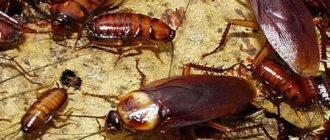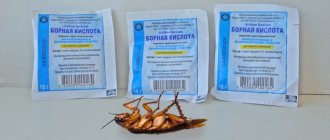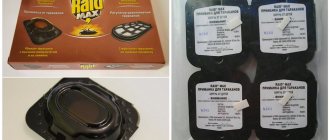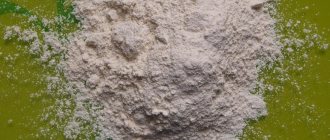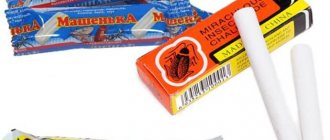What are modern Dichlorvos?
Modern Dichlorvos for cockroaches can be found under different names. This is due to the fact that sprays are produced by several manufacturers and contain components that are different from each other.
Most often found on sale:
- Dichlorvos Super;
- Dichlorvos Neo;
- Dichlorvos Varan;
- Dichlorvos Eco.
It is impossible to say unequivocally which of the listed drugs is more effective. Their mechanism of action on cockroaches is approximately the same, and their composition is similar. All of these drugs are based on substances of the pyrethroid group, excipients, and fragrances.
Operating principle
The pyrethroids on which Dichlorvos are based are synthetic substances that exhibit nerve-paralytic activity. After the insecticide enters the parasite's body, it disrupts the transmission of nerve impulses, which leads to paralysis. After some time, the insect dies.
The human task in this case is only to ensure the penetration of the active substances into the cockroaches’ body. And after spraying the aerosol cloud, this is achieved in several ways:
- Through spiracles - this occurs when the product is sprayed in places where parasites accumulate. In this case, it is possible to ensure the best result. The insecticide is quickly absorbed into the hemolymph and immediately spread throughout the body. Soon the cockroach dies.
- Through chitinous integuments - since pyrethroids have a contact effect, they are able to penetrate the body of insects even when they come into contact with chitinous integuments. Next, the active substances work according to the scheme described above - leading to paralysis and subsequent death.
- Through the oral apparatus - when sprayed, particles of the product settle on various surfaces and, if you do not carry out wet cleaning, they will remain here for a long time. Surviving individuals, when moving, will stain their paws in the insecticide and, when cleaning them with their jaws, will swallow a certain amount of the product. In the stomach, toxic components will be absorbed into the hemolymph and, as a result, poisoning will occur.
However, one treatment is not always enough. If the situation is advanced and, in addition to adult cockroaches, there are numerous nests of cockroaches in the apartment, then Dichlorvos will have to be applied 2-3 times.
Pyrethroid insecticides, which are contained in modern “Dichlorvos” for cockroaches, can remain active for two weeks and only after this period will they begin to gradually decompose in the air. Therefore, if there are no children or pets in the apartment, then after treatment it is better not to carry out wet cleaning until the end of the drug’s effect. If the situation is the opposite, then in order to avoid poisoning, it is recommended to leave a layer of the product only in hard-to-reach places - where neither children nor pets are guaranteed to reach.
Mechanism of action of the product
Modern Dichlorvos necessarily contains substances such as pyrethroids, which have a paralytic effect on the central nervous system of insects. They enter the parasite's body through inhalation or through food. Under the influence of pesticides, disturbances in the transmission of nerve impulses begin, which lead to paralysis of the respiratory organs with subsequent suffocation.
As it settles on the insect’s integument, the drug continues to exert its destructive effect for some time. Having reached the shelter, the parasite begins to “wash itself”, cleaning the poison from its paws, swallowing it with its jaws. As a result, the poison penetrates the insect’s digestive tract, causing severe poisoning.
It is important to know not only how Dichlorvos acts on cockroaches, but also the speed of its effect. With large-scale processing, the main part of the population dies immediately, another part - within a couple of hours.
If only a small amount of the chemical gets on the cockroach, there is a good chance that the insect will survive, especially if water is available. Therefore, treatment should be carried out with a drug that contains, in addition to pyrethroids, other active ingredients.
What effect does Dichlorvos have?
To understand how effective this insecticide is, you need to understand how Dichlorvos works on cockroaches. After the chemical enters the chitinous cover and into the respiratory system, the components of the product quickly interact with nerve cells, causing the inability to transmit impulses. As a result, the parasites experience asphyxia and paralysis of the limbs, and as a result they die.
Those cockroaches that have not inhaled enough vapor can survive, especially if they have access to water. In this case, if at least one or more insects are detected after treating the room, you should think about not only repeating the procedure, but also about using other insecticidal preparations in parallel with Dichlorvos.
Important! To destroy as many Prussians as possible, it is necessary to spray poison in places where they are most concentrated. It is necessary to ensure direct contact between insects and insecticide vapors.
Poison particles can retain their destructive effect for a long time (in the absence of wet cleaning). The insect stains its paws and whiskers, and upon arrival at the den it begins to actively wash itself.
The jaws of the parasite are involved in this process, so the active substance enters the digestive system and causes severe intoxication. If the population of cockroaches is small, then it is possible to get rid of them in one treatment, provided that technology is followed and high-quality products are used.
Application technology
To get rid of parasites forever, you need to poison cockroaches with dichlorvos according to all the rules, adhering to the following instructions for use:
- This drug may harm pets, especially cold-blooded animals. Therefore, it is necessary to remove cats and dogs and cages with rodents from the treatment area. Terrariums and aquariums can be covered with film, making sure that clean air reaches the pets.
- Dishes and food should be removed from the room or placed in plastic bags and sealed tightly.
- Move furniture and large household appliances away from the walls, remove wall cabinets to provide access to baseboards and other potential habitats for cockroaches. Carpets are rolled up, bedding and personal belongings are removed and taken out.
Before properly starting to treat the room, the container is shaken.
The spray is sprayed around the perimeter of the room, spraying visible individuals, as well as potential habitats of cockroaches:
- baseboards, gaps between floorboards;
- batteries;
- the floor under the furniture (if it could not be moved);
- window frames, door jambs;
- walls, floor near the sink.
The treatment is carried out using PPE (gloves, respirator, thick clothing that covers the body as much as possible). Dichlorvos is sprayed, holding the balloon at a distance of 20–30 cm from the surface. After completing the procedure, you need to leave the room for 2-3 hours, closing the doors and windows . Since Dichlorvos has a residual effect, wet cleaning should be carried out only on treated work surfaces, in places accessible to people and animals.
Efficiency of using Dichlorvos
Sometimes people notice surviving cockroaches in a room after pest control. Therefore, they are quite naturally interested in the question: does Dichlorvos help against cockroaches?
It is impossible to answer it unambiguously. This product has proven effective for spot treatment. However, if its concentration is insufficient, individual insects can survive and establish a new population. Therefore, it is advisable to combine Dichlorvos with other, less volatile agents with a long residual effect, for example, with a gel.
Dichlorvos against cockroaches: consumer reviews
It is known that “Dichlorvos” appeared on store shelves more than 30 years ago, and even then the famous aerosol began to fight against unpleasant insects. Compare derivatives of current drugs and those of that time, the composition and effect are significantly different.
The original component was more effective and did its job better, but was harmful to the human body. “Dichlorvos” for cockroaches, reviews of which concerned a product based on dimethyl dichlorovinyl phosphate, claim that it was more effective, the insects disappeared quickly and never returned.
The name “Dichlorvos” remains, but dichlorvos itself - dimethyldichlorovinylphosphate - is not in it. But, despite this replacement of components, the product did not lose its effects, it only became a little weaker and does not cope with its purpose as well.
Which Dichlorvos to choose
There are now quite a few varieties of this drug. There are sprays with aroma, unscented ones, and you can also find the traditional “smelly” chemical. Not only the appearance of the cylinders differs, but also their contents.
Modified Dichlorvos
The toxic chemical that was sold a couple of decades ago was made on the basis of dimethyldichlorovinylphosphate (abbreviated as dichlorvos). The effective drug had no significant competitors, but was toxic not only to insects, but also to people.
Most modern products of the same name do not contain organophosphorus compounds. Sprays are based on pyrethroids, which are effective, but not so dangerous to humans and have a longer duration of action. Modern dichlorvos has only the name in common with the old product - marketers use it when creating new products, since people prefer to purchase already proven, well-known chemicals that are well-known.
Modified Dichlorvos contain cypermethrin, tetramethrin, piperonyl butoxide.
Cypermethrin
Belongs to the group of pyrethroid drugs that are used to kill cockroaches and other insects. It has a hazard class 2 for warm-blooded animals, and a hazard class 1 for insects and fish. Resistant to solar radiation, does not cause addiction in cockroaches.
Cypermethrin is part of a drug such as Dichlorvos Eco. The substance is flammable and its vapors may be explosive. The peak effect of the poison occurs 2–3 hours after spraying, the residual protective effect persists for 10–15 days.
Permethrin
Included in preparations against cockroaches, it is harmful to beneficial insects, fish, and reptiles. Before using Dichlorvos, which contains this substance, it is necessary to clean all aquariums and terrariums. Low toxicity for humans. The substance belongs to the group of pyrethroids and has a nerve-paralytic effect. It is resistant to sunlight and high temperatures, has a long-lasting effect - about 2-3 weeks. Included in Dichlorvos Neo.
Piperonyl butoxide
The substance belongs to the group of pyrethroids and quickly decomposes in light. It is capable of having an acute toxic effect, enhances the effect of the use of other pesticides, accelerating the onset of paralysis by 2–5 times. It is part of such modern drugs as “Dichlorvos Innovative”, “Dichlorvos Varan A”, “Dichlorvos No. 1”. It is not the main active ingredient, so insects do not get used to it.
Preparing the room for processing
Before starting work, it is necessary to clear the room of all foreign objects. Remove paintings, move equipment and furniture to the center. Textiles must be rolled and washed. Wash dishes and personal hygiene items or put them in plastic bags. Such measures will not only protect residents from chemical poisoning, but will also prevent insects from breeding from eggs.
Particular attention should be paid to the bathroom and kitchen. Cockroaches constantly need water, so they try to stay close to it.
Before you start pest control, you need to clean the apartment: sweep out the trash, wipe off the dust. The product adheres better to cleaned surfaces and, accordingly, the residual effect of the drug lasts longer.
Food products must be placed in sealed bags or placed in plastic containers. After completing processing, the container should be wiped to prevent the poison from entering the human body.
Safety regulations
When purchasing Dichlorvos for cockroaches, odorless or with an aromatic fragrance, do not forget about its toxicity. Any form of release of the drug belongs to class 3 hazardous substances and requires caution when used.
During the disinfestation process, follow the safety rules for working with toxic substances:
- Put tight rubber gloves on your hands;
- Protect your respiratory tract with a respirator;
- Protect your eyesight with glasses.
Wear waterproof clothing on your body. You can purchase a special rubberized protective suit.
Before treatment, be sure to remove pets and family members from the apartment. The drug has a serious toxic effect on fish, ornamental birds, and cats.
Pack food items in plastic bags or airtight containers and place them in the refrigerator. Take the dishes out onto the balcony. It is important that she does not come into contact with Dichlorvos vapors.
Safety precautions
Dichlorvos is not capable of causing serious harm to health. Poisoning with this drug is most easily tolerated by people, a little worse by pets. Piperonyl butoxide, which is part of many sprays, has a negative effect on the well-being of rats and mice. All pyrethroids are poisonous to reptiles, cockroaches, and fish.
Warm-blooded animals, having inhaled Dichlorvos vapors, become aggressive, they exhibit hyperactivity, and noticeable tremor of the limbs.
Preparations containing a mixture of permethrin and cypermethrin are practically safe for humans (hazard class 3). In rare cases, they may cause redness and burning if they come into contact with the skin.
To avoid unpleasant consequences, disinfestation with Dichlorvos must be carried out while wearing gloves, tight, closed clothing, and a respirator.
Spray manufacturers mask the unpleasant odor with fragrances. Despite the pleasant aroma of the drugs, during processing you can easily inhale the vapors of the poison. At the first signs of illness, you must leave the room and go out into the fresh air.
